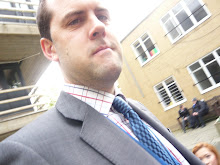 This shot creates drama within the flashback. The angle perceives him to be more powerful and dominant, on a whole building more suspense when she takes revenge and kills him
This shot creates drama within the flashback. The angle perceives him to be more powerful and dominant, on a whole building more suspense when she takes revenge and kills him
 In this shot of the Co-star we have used a low tilt to emphasise the female character's power. Here we have placed the victim at an angle for the viewer to see that there is no possible way the victim could see Nicola entering the room. From the props the viewer is able to see that the victim is drinking which also would slow his reactions and judgement. We have used the stereotype that most abusers are in some way influenced by alcohol.
In this shot of the Co-star we have used a low tilt to emphasise the female character's power. Here we have placed the victim at an angle for the viewer to see that there is no possible way the victim could see Nicola entering the room. From the props the viewer is able to see that the victim is drinking which also would slow his reactions and judgement. We have used the stereotype that most abusers are in some way influenced by alcohol. In this short we have used the rule of thirds, placing the character of the left of the screen enabling the viewer to see the empty space she's looking into as she is reflecting and looking thoughtful. In this shot she is dressed casually and wearing her glasses; her thoughts are internalised and you are able to see the trees and housing behind her. Her glasses symbolise that she is unable to see the world clearly, also they hide a majority of her face showing she hides away from the world behind this sort of barrier.
In this short we have used the rule of thirds, placing the character of the left of the screen enabling the viewer to see the empty space she's looking into as she is reflecting and looking thoughtful. In this shot she is dressed casually and wearing her glasses; her thoughts are internalised and you are able to see the trees and housing behind her. Her glasses symbolise that she is unable to see the world clearly, also they hide a majority of her face showing she hides away from the world behind this sort of barrier.1st)

As seen in other thriller films, a close up on the weapon is often used to emphasize the importance of it, and further build tension, showing the forthcoming scene is going to revolve around this prop. Additionally, this shot was used as a cutaway, which was an idea taken from observing other thriller films (this very convention for example is visible in the Kill Bill opening I posted earlier).
Furthermore, we ensured that the knife was highlighted by extra lighting to firstly show the importance of it, secondly to make it stand out to the viewer, and finally to create an eerie effect (the knife for example is lighted much more than Nicola, and her face isn't even visible, which shows exactly what the audience should be paying attention to, and what the forthcoming scene is going to revolve around).
 Here is the convention used in 'A Clockwork Orange' , a thriller which was an important influence. Not only does it use a cutaway, with the knife domineering the shot, but also the leads main body is unseen (as in ours).
Here is the convention used in 'A Clockwork Orange' , a thriller which was an important influence. Not only does it use a cutaway, with the knife domineering the shot, but also the leads main body is unseen (as in ours).2nd)

A high angle shot on the victim, signifying the dominance of the killer and weakness of the victim is a convention used in most genres, so while not exclusive to, it is still used greatly in Thrillers. I researched the technique further however prior to filming, and while I had seen it used in thrillers, the research satisfied my questions (from http://en.wikipedia.org/wiki/High-angle_shot):
"if the [high angle] shot represents a character's point of view the shot can also be used to make the character tall, more powerful or threatening."Secondly we placed the victims legs rested on the table, to further emphasize his naturalistic state, and signify a disruption to this will occur. It also makes him less powerful, in that he isn't expecting whats about to happen, which in effect further establishes the leads dominance of the scene.
Finally, as you can see on the desktop, is the file glass_crash.wav. I remembered the effect often used in thrillers of a common sound effect reversed which gave a tension building climax effect. Most noticeably I remembered it being used in Lost, and felt Lost as one of the "pioneers" of the thriller genre at creating tension.
(Convention noticeable at 25 sec - 30 sec)
- Elliott.

A good entry. Can you include anything about the conventions of this as an opening. What do all openings have?
ReplyDelete